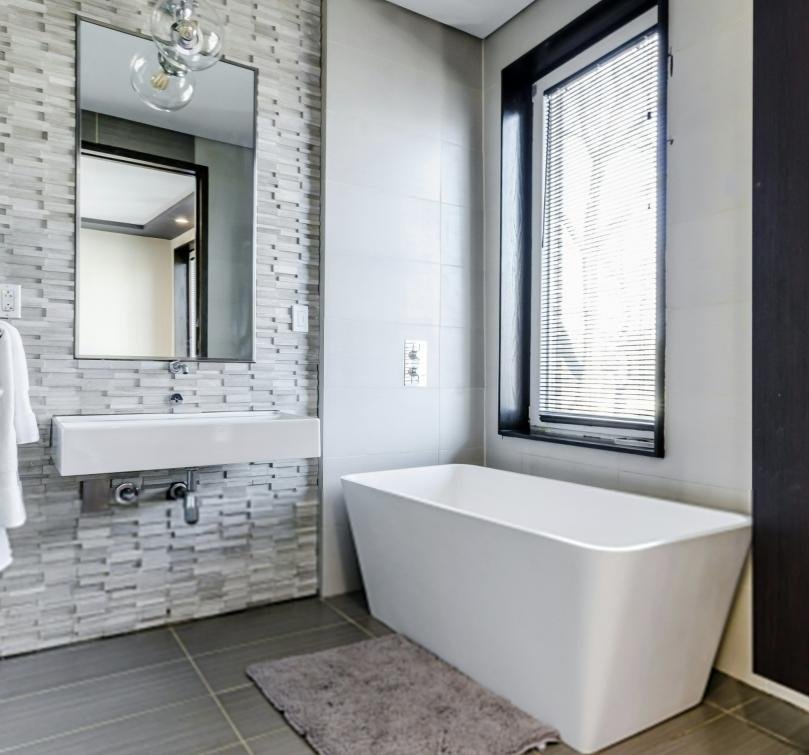Introduction to Bath Rugs and Bath Mats
In the realm of bathroom decor, bath rugs and bath mats serve as essential components that contribute to both aesthetic appeal and functional comfort. While these two items are often used interchangeably, they cater to different purposes and exhibit unique characteristics that set them apart. Understanding these differences is key to effectively incorporating them into your bathroom space.
Bath mats are typically designed to be placed directly in front of sinks, tubs, or showers to absorb water and provide a non-slip surface. Their primary function is to prevent slipping on wet floors and absorb moisture, ensuring safety and reducing the risk of accidents. Made from quick-drying materials such as cotton or microfiber, bath mats are intended for regular use, easy cleaning, and fast drying, making them practical additions to any bathroom.
On the other hand, bath rugs often have a thicker, plusher feel, serving primarily as decorative elements that enhance the overall aesthetic of the bathroom. They are available in various sizes, textures, and patterns, allowing homeowners to express personal style and complement existing decor. While bath rugs may provide some level of comfort and warmth underfoot, they are generally less focused on functionality, such as moisture absorption and slip prevention, than their mat counterparts. As a result, bath rugs may not be as suitable for heavy-use areas where direct water exposure is common.
This distinction between bath rugs and bath mats can create confusion, leading individuals to use the terms interchangeably. However, recognizing the intended purpose and design of each will assist in making informed decisions about their placement and selection, ensuring that both comfort and decor are enhanced in your bathroom environment.
Defining Bath Rugs
Bath rugs are often considered a stylish and functional addition to any bathroom, effectively combining comfort with aesthetic appeal. Typically larger than bath mats, bath rugs are designed to cover a more substantial area of the floor, providing warmth and softness underfoot. Generally measuring at least 24 inches in width, they can extend significantly, accommodating various bathroom layouts and designs.
When it comes to materials, bath rugs are predominantly made from plush textiles such as cotton, microfiber, or even memory foam. These materials not only enhance the overall comfort but also offer increased absorbency, making bath rugs an appealing choice for use post-shower or bath. Their thicker construction distinguishes them from standard bath mats, which tend to be more utilitarian in nature. The rich fabrics used in bath rugs contribute to a more luxurious feel, elevating the bathroom’s ambiance.
Design features are another key aspect that sets bath rugs apart. They often come in an array of styles, colors, and patterns, allowing consumers to select options that complement their existing décor. From vibrant prints that serve as a statement piece to subdued, neutral tones that blend seamlessly with the surroundings, bath rugs provide opportunities for personalization in bathroom design. Additionally, some bath rugs feature non-slip backing, enhancing safety while maintaining their decorative qualities.
In terms of purpose, bath rugs extend beyond mere functionality; they play a vital role in enhancing the overall aesthetic of a bathroom. By integrating various design elements such as textures, colors, and shapes, they can transform a simple bathroom into a stylish sanctuary. Thus, bath rugs serve not only as practical items but also as important decorative components that elevate a bathroom’s overall decor.
Defining Bath Mats
Bath mats are essential bathroom accessories designed primarily for practical purposes. Typically smaller in size compared to bath rugs, they serve a focused role, offering both safety and functionality within the bathroom environment. Commonly placed in high-traffic areas, such as in front of sinks, bathtubs, or showers, bath mats are strategically positioned to absorb excess water, thereby minimizing the risk of slips and falls on wet surfaces.
One of the defining characteristics of bath mats is their slip-resistant properties. Many bath mats are constructed with materials that enhance grip, providing users with a stable footing when stepping out of a wet area. This feature is particularly important for households with children or elderly individuals, where safety is a primary concern. The ability of bath mats to quickly absorb moisture ensures that the floor remains dry, further reducing the likelihood of accidents.
Additionally, bath mats are available in a wide range of colors, patterns, and styles, allowing them to complement various bathroom decor. This versatility means that while bath mats serve a vital functional role, they can also enhance the aesthetic appeal of the bathroom space. In summary, bath mats are compact, practical, and safety-oriented bathroom accessories, essential for maintaining cleanliness and preventing accidents in wet environments.
Material Differences between Bath Rugs and Bath Mats
When assessing the materials used in bath rugs and bath mats, it is essential to note the fundamental differences that influence their functionality and maintenance. Bath rugs are typically crafted from soft textiles, making them a plush and comfortable addition to any bathroom space. Common materials for these rugs include cotton, polyester, and even natural fibers like bamboo and cotton blends. Their softness provides a luxurious feel, often enhancing the overall aesthetic of the bathroom.
On the other hand, bath mats are primarily designed for practical purposes, focusing on absorbency and quick-drying capabilities. They are often made from materials such as microfiber, which effectively absorbs moisture while maintaining a low profile. Other materials frequently found in bath mats include rubber and PVC, which emphasize durability and resilience against water exposure. These materials not only help in moisture management but are also easier to clean and maintain compared to the softer fabrics found in bath rugs.
Moreover, the resilience of the materials plays a crucial role in the longevity of both bath rugs and mats. While bath rugs may need more frequent washing to prevent mildew and odors due to their plush nature, bath mats often dry more quickly after each use, minimizing the risk of such issues. It is also worth noting that some bath mats come with non-slip backing, enhancing safety by preventing slippage on wet floors. The choice between bath rugs and mats largely depends on individual preferences regarding comfort versus functionality. In essence, the material choices reflect the differing purposes of these two bathroom accessories.
Care and Maintenance: Bath Rugs vs Bath Mats
Proper care and maintenance are essential for prolonging the lifespan of both bath rugs and bath mats, ensuring they remain functional and visually appealing. While both products serve the purpose of enhancing safety and comfort in the bathroom, their materials and construction often dictate specific care requirements.
Bath mats, typically made from quick-drying materials like microfiber or cotton blends, generally require machine washing on a gentle cycle. Using a gentle detergent will help avoid damage to the fibers. It is advisable to wash bath mats separately from heavier laundry items to prevent wear and tear. Following the washing process, machine drying on a low heat setting will effectively remove moisture while maintaining the mat’s integrity. For those who prefer air drying, laying the mat flat or hanging it can help retain its shape and prevent sagging.
On the other hand, bath rugs, which may feature thicker piles and varied materials such as wool or synthetic fibers, might have different maintenance needs. For optimal care, hand washing in cold water is often recommended, particularly for more delicate options, followed by air drying. Regular vacuuming can help to eliminate dust and debris, preserving the appearance of bath rugs. If a bath rug is machine washable, it is crucial to read the care label for specific instructions to prevent shrinkage or damage.
To enhance the lifespan of both bath rugs and bath mats, it is beneficial to regularly rotate their placement and avoid exposing them to excessive moisture or direct sunlight, as this can lead to fading or mold growth. Implementing these care practices ensures that both bath rugs and bath mats remain durable and aesthetically pleasing in your bathroom environment.
Aesthetic Appeal: Incorporating Bath Rugs and Mats into Your Bathroom Design
When it comes to bathroom design, the choice of bath rugs and mats can significantly enhance the overall aesthetic appeal of the space. These items not only serve a practical purpose but also contribute to the decorative style, making them essential elements of bathroom décor. Selecting the right bath rug or mat involves considering various factors, including color, patterns, and themes that align with your bathroom’s design.
Color plays a critical role in establishing mood and ambiance in any room, including bathrooms. Neutral shades such as beige, gray, or white are versatile and work well in minimalist settings, while bold colors like navy blue or forest green can create a focal point and add a touch of sophistication. When integrating colors, consider the existing color palette of your bathroom fixtures, tiles, and accessories to ensure a harmonious look.
Patterns and textures can also elevate the visual interest of a bathroom space. Geometric patterns lend a modern touch, while floral designs can introduce a more traditional or vintage feel. Textured bath rugs, such as shag or woven options, offer a tactile experience that can make the area feel warm and inviting. Choose patterns that complement rather than clash with other elements in the bathroom, thereby achieving a cohesive design.
Themed coordination is another significant aspect of incorporating bath rugs and mats into your bathroom’s aesthetic. Whether your design leans towards coastal, rustic, or contemporary, select rugs that resonate with the overarching theme. For instance, a beach-themed bathroom might benefit from light, airy colors and beach-inspired motifs. By aligning your bath rugs and mats with your chosen theme, you can create a seamless flow that enhances the ambiance and visual appeal of your bathroom space.
Choosing Between Bath Rugs and Bath Mats: What to Consider
When deciding between bath rugs and bath mats, several factors must be considered to align your choice with individual preferences and practical requirements. To start, assess the size of the space where the item will be placed. Bath mats are usually designed for smaller areas directly outside the tub or shower, providing quick absorbency and safety. In contrast, bath rugs can cover larger spaces, often contributing to the overall aesthetic of the bathroom while adding a touch of comfort.
Safety is another paramount concern. Bath mats typically feature non-slip backing to prevent slipping and accidents, which can be particularly important for families with children or elderly individuals. On the other hand, bath rugs, although more decorative, may not provide the same level of grip and security. Therefore, determining the safety needs of the household can significantly influence the decision between the two.
Intended use is equally important. If the goal is primarily functional, a bath mat may be the most suitable option because of its quick-drying capabilities and slip-resistant features. Conversely, if the aim is to enhance the decor while also providing some comfort and style, a plush bath rug could be the better choice. It’s essential to evaluate whether the item will be subjected to frequent use and wet conditions or if it will serve a more decorative purpose.
Finally, personal style and the overall theme of the bathroom play a crucial role. Bath rugs and bath mats come in various colors, patterns, and textures. While bath mats often emphasize practicality, rugs offer a broader visual appeal that can complement other bathroom design elements. Balancing aesthetics with functionality will lead to a satisfying selection that meets both utility and style preferences.
Sustainability Considerations: Eco-Friendly Options
As consumers become increasingly aware of environmental issues, the market for eco-friendly bath rugs and mats is expanding. Sustainable materials are at the forefront of this movement, offering alternatives that minimize environmental impact while maintaining functionality and aesthetic appeal. Common sustainable materials include organic cotton, bamboo, and recycled textiles. Organic cotton is grown without harmful pesticides and fertilizers, reducing the chemical load on the environment, whereas bamboo grows rapidly and requires minimal resources, making it an ideal eco-friendly option.
Recycled textiles, often sourced from post-consumer waste, such as plastic bottles or discarded fabrics, exemplify how innovative manufacturing practices can transform waste into functional home products. These materials not only decrease landfill contributions but also lower the carbon footprint associated with new textile production. When selecting bath rugs and mats, consumers should look for products certified by reputable organizations, which indicate adherence to environmental standards, such as Oeko-Tex® or Global Organic Textile Standard (GOTS).
Several brands have prioritized sustainability in their product lines, offering environmentally conscious options for consumers. Companies that focus on ethical sourcing, transparent manufacturing processes, and commitments to reducing carbon emissions are making significant strides in promoting greener choices in the home decor sector. Moreover, supporting brands that actively engage in sustainability initiatives can result in a positive impact on the environment.
Making eco-friendly choices regarding bath rugs and mats contributes to a greener home and broader sustainable movement. By opting for products made from sustainable materials, consumers are not only enhancing their living spaces but also supporting practices that conserve resources and reduce ecological footprints. This consideration ensures a balance between personal preferences and environmental stewardship, fostering long-term changes in consumer behavior towards more sustainable living.
Conclusion: The Right Choice for Your Bathroom
In conclusion, understanding the distinctions between bath rugs and bath mats is essential for making an informed decision that aligns with your bathroom’s aesthetic and functional needs. Both bath rugs and bath mats serve their respective purposes, yet they differ in materials, design, and practicality. Bath mats are generally smaller, designed primarily for safety and moisture absorption immediately outside the shower or tub. They often feature rubber or non-slip backing to prevent slips and falls, making them an ideal choice for households with children or elderly individuals.
On the other hand, bath rugs tend to encompass a larger area and provide an added layer of comfort and style to the bathroom environment. Crafted from various materials—including cotton, microfiber, and synthetic fibers—they often come in elaborate designs and colors, making them more of a decorative element within the room. Although they can absorb moisture, bath rugs may not always have the same anti-slip properties as bath mats, necessitating additional considerations for their placement to ensure safety.
When choosing between a bath rug and a bath mat, consider the specific needs of your bathroom. If safety and quick drying are your priorities, a bath mat may be more suitable. Conversely, if you seek to enhance your bathroom’s overall decor and comfort, a bath rug could be the better option. Ultimately, being aware of the key differences and similarities between these two items helps you select the most appropriate choice, ensuring both functional utility and aesthetic appeal suit your individual preferences and requirements.






